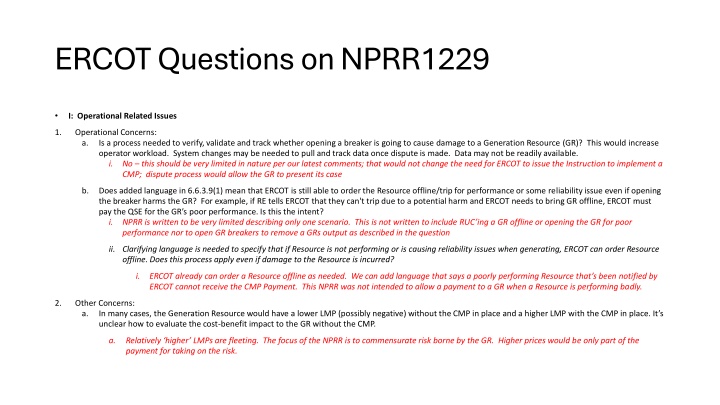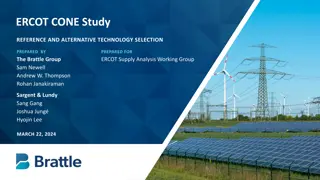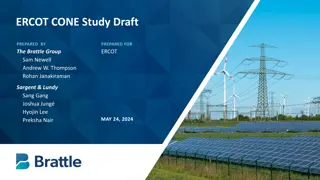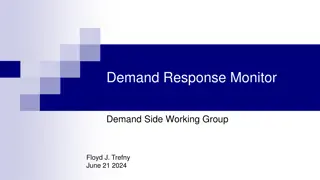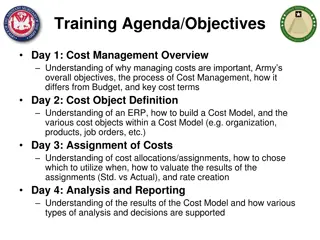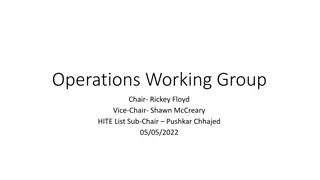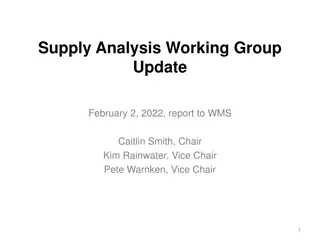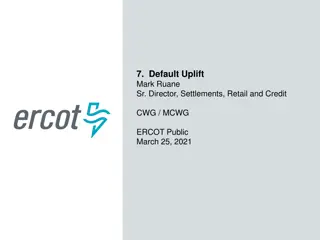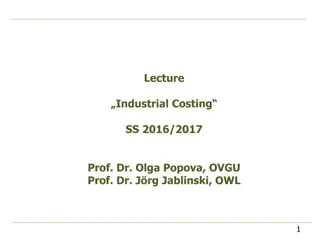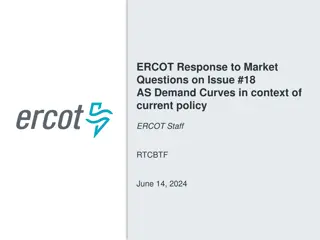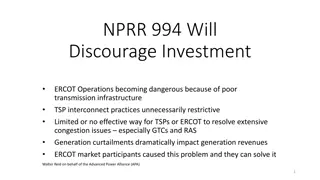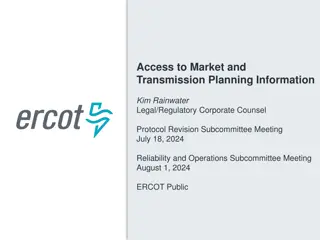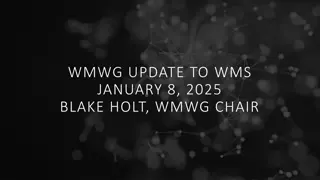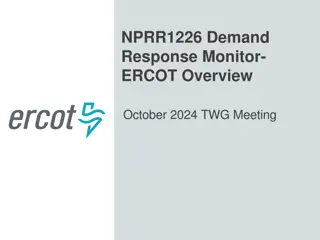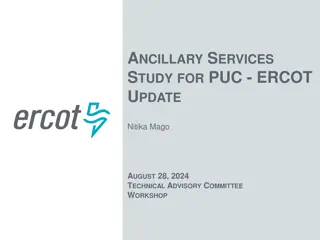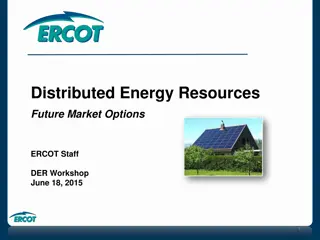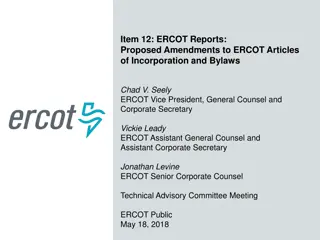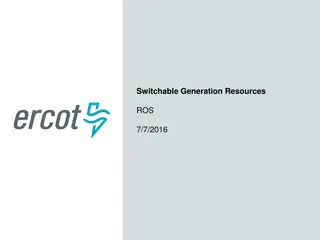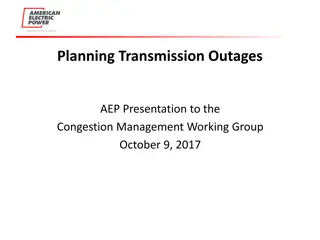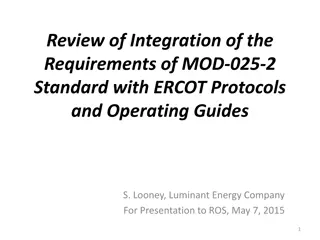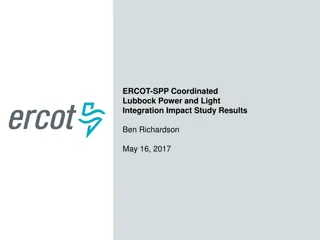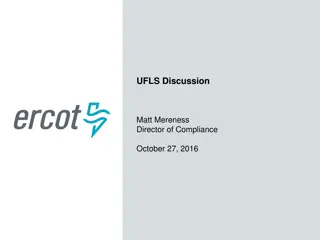ERCOT Questions on NPRR1229: Operational Concerns and Cost Issues
The content discusses operational concerns related to verifying and tracking breaker operations and cost-related issues regarding compensations for Generation Resources in ERCOT. It covers topics such as system changes, dispute processes, CMP payments, LMP evaluation, cost-benefit impact analysis, opportunity cost payments, financial losses, and outage durations.
Download Presentation

Please find below an Image/Link to download the presentation.
The content on the website is provided AS IS for your information and personal use only. It may not be sold, licensed, or shared on other websites without obtaining consent from the author.If you encounter any issues during the download, it is possible that the publisher has removed the file from their server.
You are allowed to download the files provided on this website for personal or commercial use, subject to the condition that they are used lawfully. All files are the property of their respective owners.
The content on the website is provided AS IS for your information and personal use only. It may not be sold, licensed, or shared on other websites without obtaining consent from the author.
E N D
Presentation Transcript
ERCOT Questions on NPRR1229 I: Operational Related Issues 1. Operational Concerns: a. Is a process needed to verify, validate and track whether opening a breaker is going to cause damage to a Generation Resource (GR)? This would increase operator workload. System changes may be needed to pull and track data once dispute is made. Data may not be readily available. i. No this should be very limited in nature per our latest comments; that would not change the need for ERCOT to issue the Instruction to implement a CMP; dispute process would allow the GR to present its case b. Does added language in 6.6.3.9(1) mean that ERCOT is still able to order the Resource offline/trip for performance or some reliability issue even if opening the breaker harms the GR? For example, if RE tells ERCOT that they can't trip due to a potential harm and ERCOT needs to bring GR offline, ERCOT must pay the QSE for the GR s poor performance. Is this the intent? i. NPRR is written to be very limited describing only one scenario. This is not written to include RUC ing a GR offline or opening the GR for poor performance nor to open GR breakers to remove a GRs output as described in the question ii. Clarifying language is needed to specify that if Resource is not performing or is causing reliability issues when generating, ERCOT can order Resource offline. Does this process apply even if damage to the Resource is incurred? i. ERCOT already can order a Resource offline as needed. We can add language that says a poorly performing Resource that s been notified by ERCOT cannot receive the CMP Payment. This NPRR was not intended to allow a payment to a GR when a Resource is performing badly. 2. Other Concerns: a. In many cases, the Generation Resource would have a lower LMP (possibly negative) without the CMP in place and a higher LMP with the CMP in place. It s unclear how to evaluate the cost-benefit impact to the GR without the CMP. a. Relatively higher LMPs are fleeting. The focus of the NPRR is to commensurate risk borne by the GR. Higher prices would be only part of the payment for taking on the risk.
ERCOT Questions on NPRR1229 II: Cost related Issues 1. How would ERCOT know exactly which Resource costs were caused by the CMP tripping unit offline instead of other reasons, such as not performing regular maintenance? a. The costs that would be included here would be limited in nature to the trip. Language was included that states direct result of the line operation. Tripping a Resource from an operating breaker would be identifiable. 2. Is the intent of the NPRR to pay for financial losses associated with bilateral contracts to sell energy at its Resource Node for the entire duration of the outage, which could take weeks to resolve? 1. A GR that takes on the risk to get tripped when it has an obligation other than RT should be compensated for such. This is part of operating the transmission grid as is the current paradigm. ERCOT would be able to identify whether a Resource is asking for more than is necessary. 3. The NPRR requires Opportunity Cost payments in the Real-Time Market if the Resource does not meet a) and b) below: a) Recovering costs due to a bilateral contract, or b) Recovering incremental costs as Resource is trying to serve its Load located in same QSE as Resource. i. ERCOT: This calculation is similar to the current HDL Override (HDLO) cost recovery process. However, for HDLO ERCOT determines demonstrable financial losses on an interval-by-interval basis whenever the QSE is capacity short. It s unclear what is meant by does not meet items a) or b) above. i. It was not intended for a Generation Resource to be recover both opportunity costs and A or B above simultaneously ii. ERCOT: Is the policy to pay for an Opportunity Cost on items a) and b) above for the entire duration of the outage, regardless of how long it takes for the outage to resolve? i. Submitted comments to limit the amount of time to 10 Operating days for opportunity costs and bilateral/contractual losses
ERCOT Questions on NPRR1229 1. Opportunity Cost calculation assumes the Resource would have been operating at its HSL had it not been for the outage, which may not have been the case. Is this the intent? a. This is the simplest approach to assume at HSL which is why HSL was chosen. There is the capacity opponent to a Resource which is overlooked if an attempt is made to solely paid on energy. E.g. a Resource operator has the opportunity to sell its full Resource capacity or the ability to hedge the full capacity of its Resource when it is available. The energy sold is just the mechanics of the market. I think that a bilateral contract would reveal how much of a Resource would be sold per the agreement. 2. Is the intent to pay for actual direct costs for equipment incurred due to a Forced Outage? a. The intent is to pay for the repair as costs directly-related to a trip should be limited in nature in STEC s belief. Is there a cap on how much ERCOT should approve in outage costs? a. At this time no, however this isn t envisioned with an outage that is never-ending, only as the costs that are associated as a result of the trip . 3. 4. The NPRR proposes that the time frame termination to be included in CMP Energy Payment is until the sooner of: a. The Generation Resource is On-Line and available for Dispatch as per telemetry. b. The first hour of availability for ERCOT Dispatch (e.g. Resource Status other than OUT) as per the COP; or c. The latest planned end of the Generation Resource Outage as shown in the Outage Scheduler. i. ERCOT: Will ERCOT be expected to make a CMP Energy Payment for the entire period of the outage, even if it lasts several weeks or months? i. 10 Operating days for the bilateral and/or contractual and/or opportunity costs
ERCOT Questions on NPRR1229 III: Other settlements related issues 1. The CMP Energy Payment settlement equation does not seem complete and requires further review and discussion. How this will need to change is subject to the policy decisions made. a. We think its prudent to get ERCOT s help with equations. We are onboard with not providing an RT opportunity payment + bilateral losses at the same time, unless the quantities are different. 2. The NPRR should include a provision that within 60 days of the issuance of a Real-Time Market (RTM) Initial Statement for an Operating Day impacted by a CMP, the QSE should file a Settlement and billing dispute consistent with the dispute process described in Section 9.14, Settlement and Billing Dispute Process. This is similar to the treatment of OSA, 5.6.5.1 Make-Whole Payment for Canceled or Delayed Outages for OSAs. a. STEC understands and is ok with that approach
